| کد مقاله | کد نشریه | سال انتشار | مقاله انگلیسی | نسخه تمام متن |
|---|---|---|---|---|
| 6408680 | 1629466 | 2015 | 13 صفحه PDF | دانلود رایگان |
- Bedrock and soil rich in heavy metals and sulphur reflect the geochemistry of peat.
- Topography, paludification, plant species and drainage affect geochemistry of peat.
- Anthropogenic activities on sulphide rich peatlands pose an environmental risk.
The chemical composition of peat cores sampled from nine drained peatland catchments overlying either black schist or felsic bedrock was studied in Finland. Black schist is enriched in heavy metals, sulphur and graphitic carbon, and therefore it is susceptible to weathering whereas felsic rock types in the study region are more resistant and contain only negligible amounts of heavy metals, sulphur and carbon. A total of nineteen cores down to the underlying regolith were taken and electrical conductivity was measured in the field. The peat cores were divided into 160 peat samples for the determination of chemical composition and acidity. As a result of weathering, diffusion into the ground water and adsorption by the peat, concentrations of As, Co, Cu, Fe, Hg, Mn, Ni, Zn, and S, as well as electrical conductivity were expected to be greater in the peat overlying black schist than in peat overlying felsic rocks and this difference was assumed to be strong in the bottom layers and to weaken near the surface. The basal Carex (sedge) peat layer showed elevated concentrations of elements compared to the upper Sphagnum (moss) peat layers. The effect of peatland margins and flooding also exerts some influence on higher Cu, S and Fe concentrations. Ambient environmental features and conditions, such as slope and aspect affected peat chemistry in two catchments in particular. The first catchment showed high heavy metal and trace element contents associated with peat accumulation on sloping terrain, as ground water discharges at a spring on a rather steeply sloping surface. Another catchment with lower heavy metal and trace element contents represents peat accumulation in a well-leached watershed characterized by sandy deposits within a flat valley floor and an acidity that induced the development of a Sphagnum bog phase during the early stages of mire formation. In addition to the chemical concentration of underlying bedrock and soil, the factors affecting element concentrations in peat were the topography of the environment including paludification mode and species composition and the subsiding relations of the peatland and drainage. Special caution should be paid when excavation is carried out on sites containing high sulphide concentrations in bedrock, overburden or peat, e.g. ditch network maintenance or peat harvest can lead to enhanced leaching of acidity and heavy metals. Anthropogenic activities on sulphide rich peatlands pose an environmental risk.
Journal: Geoderma - Volumes 239â240, February 2015, Pages 280-292
